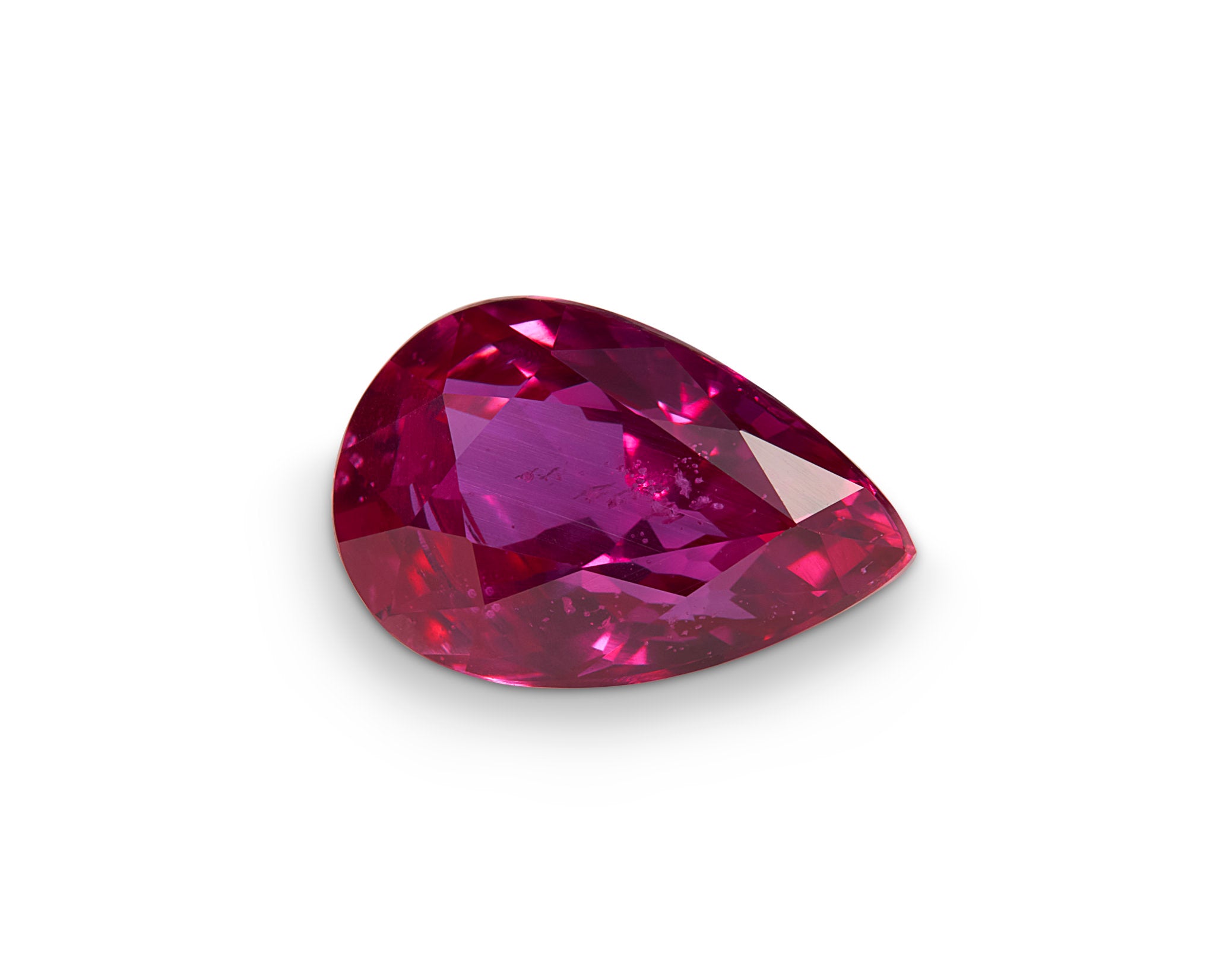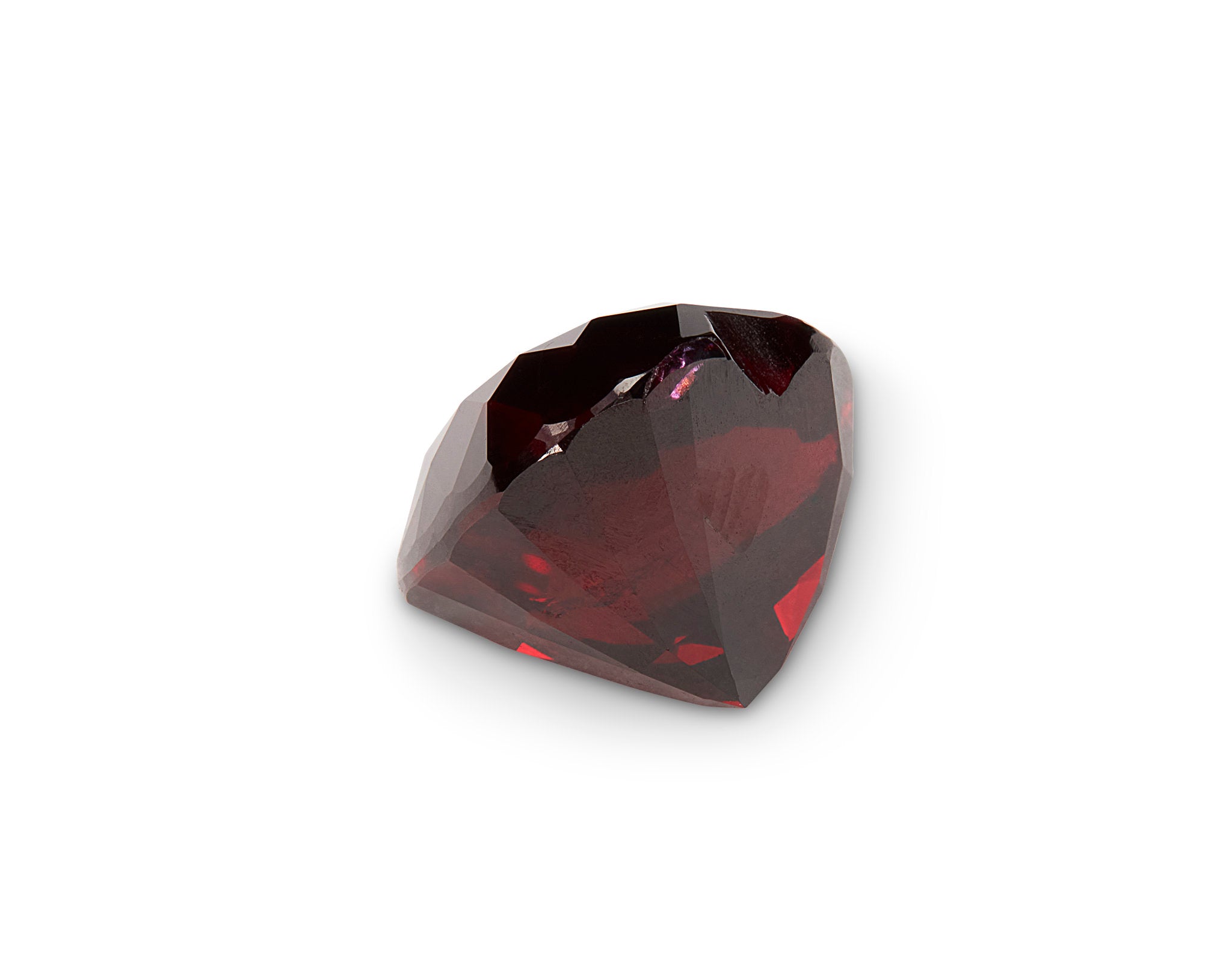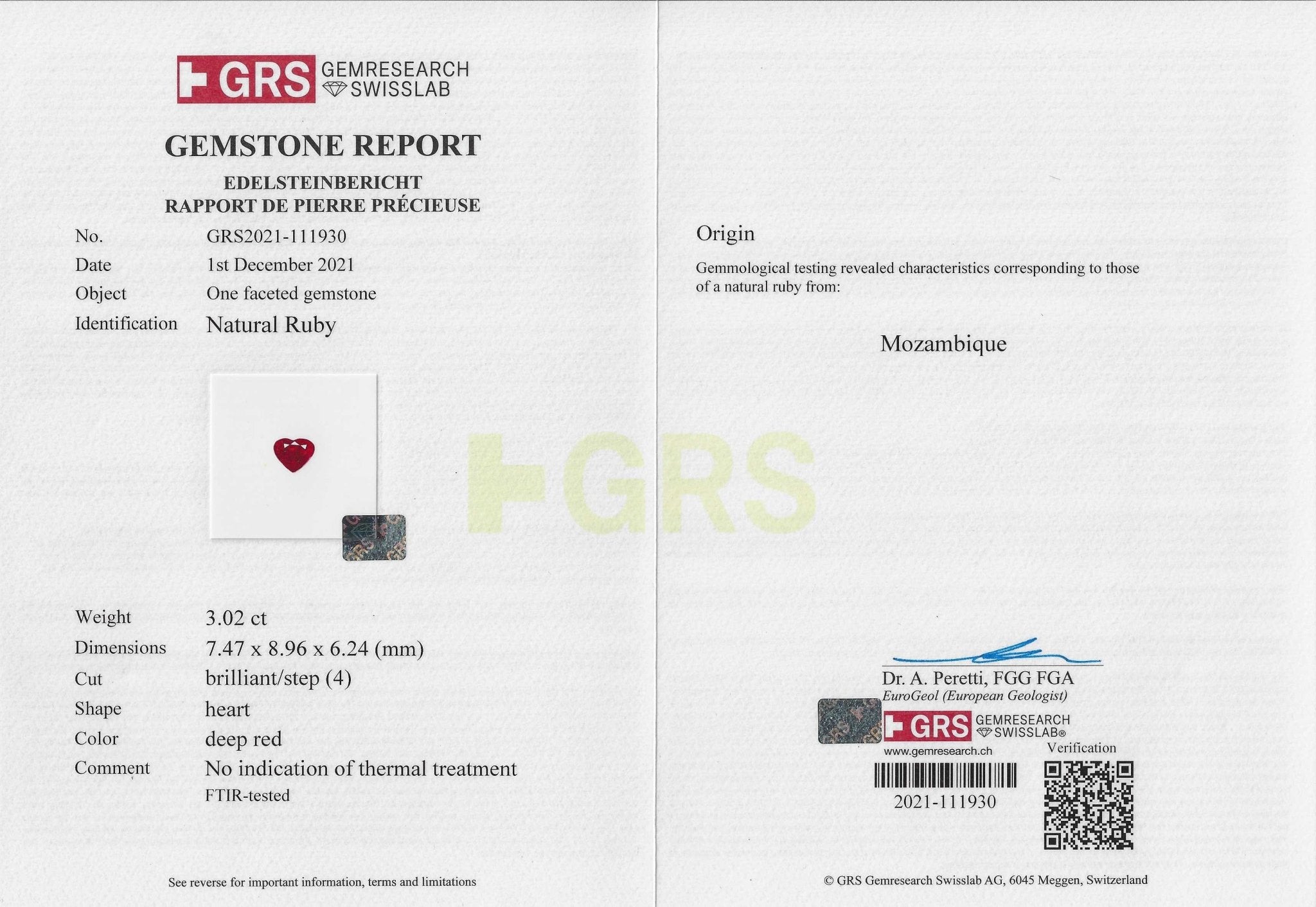Ruby
Everything you need to know
A Buying Guide For Ruby,
The Rarest Precious Gemstone

Buying Ruby at the Chanthaburi Gems Market in Thailand
Table of Contents
- What is a Ruby?
- Where do Rubies Come From?
- What is a Ruby Worth?
- The Brief and Vibrant History of Ruby
- July's Birthstone
- Rubies for Sale
Here at The Sapphire Merchant, we pursue Earth's most beautiful rubies. Each one is discovered during our travels to the world's most famous gem markets, carefully selected for our collection, brought home to New Zealand to be catalogued and then lovingly offered to you.
1. What is a Ruby?
Ruby derives its name from the Latin Rubens, which directly translates to red, and is a variety of the mineral 'corundum' belonging to the same family as sapphire. Colour is what distinguishes ruby from sapphire. Rubies are exclusively red, while sapphires are blue or any other colour.
Ruby grows in a triagonal crystal system and rates 9 on the Mohs hardness scale, its hardness only second to a diamond. Its lustre is vitreous; its specific gravity (SG) is 4.0 - 4.1, and its refractive index (RI) is 1.76 - 1.78.

Ruby in its rough form, uncut form.
What Gives a Ruby its Colour?
The corundum mineral is a combination of aluminium oxide. A trace of chromium gives Ruby its distinct red colour and sets it apart from sapphire. Rubies occur as bright red, red, purplish or brownish red, and pinkish red. The more chromium a ruby contains, the more vibrant the red colour.
The red colour of Ruby varies with individual deposits, and characteristic red shades of rubies originate from different countries. Burmese Ruby (Mong Hsu) is a full-bodied red with a touch of orange, often called 'pigeon blood' or 'Burmese red'. A Ceylon Ruby is a more pinkish variety of red. A Thai Ruby is a slightly violet shade of red and often exceedingly brilliant, and an African Ruby can be a brownish shade of red.
Aclear transparent, and faultless ruby of a uniform deep red colour is at present time the most valuable stone known ~ Max Bauer (1896)
Why are Rubies Heated?
Heat treatment or thermal treatment in ruby is considered acceptable, even in high-quality examples. Approximately 95% of Rubies on the market have heat applied to improve the colour and clarity of the gemstone. Heating can, for example, remove the brown tones from African rubies and the blue tones from Burmese rubies.
Unheated rubies are particularly rare, and this is reflected in their price. An example of a price difference is that if you had two Burmese rubies graded the same colour, clarity, and carat size, the price of the unheated ruby could easily exceed twice to five times that of the matching heated ruby option.
Other treatments of rubies include lead and glass filling, heat treatment with flux, and surface filling, which substantially lower the value of rubies but increase their overall appearance.

The Ruby Mines, Valley of Mogok, Upper Burma
2. Where do Rubies Come From?
Rubies Mined Mong Hsu in Myanmar (Burma)
There is one origin that trumps all others, and that is ruby from Burma (now Myanmar). Still referred to as Burmese Ruby, the most sought-after Burmese Rubies are from the Mogok Stone Tract in Upper Burma and are unheated. Ruby mining in Burma spans back to 1576 AD but became more organised in 1886 when a British firm established Burma Ruby Mines, LTD. and implemented modern mining techniques to extract the Ruby material from the ground. In 1962, a communist regime took power in the country and nationalised all gem mining enterprises, allowing no foreign ownership. This resulted in a drastic reduction in the supply of rubies to the world. The future of mining in the Mogok region of Burma is still being determined. In 2016, the USA and the UK imposed sanctions on Myanmar, banning direct and 3rd party imports of ruby from the three largest gem suppliers: Myanmar Ruby Enterprise, Myanmar Imperial Jade Co. and Cancri (Gems and Jewellery) Co. This teamed with a significant reduction of quality ruby material being pulled from the ground due to years of heavy extraction, has made the famed Burmese Ruby incredibly rare and difficult to obtain. The few Burmese Ruby options we see on the market are often older stock that have returned into circulation. As time passes, we will see fewer and fewer Burmese Rubies available, making them an astute investment that will never decrease in value.
Rubies Mined in Mozambique
Mozambique has become the most consistent source of Pigeon Blood Rubies on the market today. In the 1990s, British mining company Gemfields partnered with a Mozambican company to establish Montepuez Ruby Mining Limitada. Montepuez is the region where the ruby deposit was discovered. The success of mining here has been attributed to the easy access to the mineral, the geographic location of the mine, with accessible roads and a nearby port, and the exceptional ruby material being extracted from the ground. Some of the best Pigeon Blood Rubies available on the market today are from Mozambique. Due to the reliable flow of gem material, unheated options are within reach of those wanting to invest in this coveted and valuable gemstone.
1.42ct Pigeon Blood Ruby
Mined from deep within the earth, then lovingly hand-faceted into a classic oval cut to reveal its exquisite hidden brilliance, let this rare unheated 1.42ct Pigeon Blood Ruby from Mozambique be your moment-defining treasure.
Winza Rubies mined in Tanzania
The Winza deposit in Tanzania was discovered in 2008 and is now an important source of high-quality pigeon blood ruby that rivals that of the rubies seen from Myanmar and Mozambique. Winza rubies are known for having minimal inclusions, high clarity, and vivid colour saturation. Winza rubies have high iron (fe) content, distinguishing them from rubies from other origins. This unique characteristic creates a bluish-violet colour zoning that can give an optical effect of the ruby showing distinct shades of red, pink or purple. For this reason, Winza rubies are sought after by gemstone collectors and jewellery aficionados.
Ceylon Rubies Mined in Sri Lanka
Sri Lanka is the most significant source of corundum in modern times, and there is a prestige that comes with gems from this origin. Ceylon rubies are rare and are cherished for their soft reddish-pink hue and high clarity. A unique characteristic of rubies from this origin is a natural inclusion known as silk, made up of fine rutile needles, which gives the ruby a creamy, velvety texture. Known as star ruby they faceted into a cabochon to showcase the optical phenomenon, asterism, which creates a 6-point star on the face of the gemstone as light interacts with the surface.
2.22ct Ruby
Mined from deep within the earth, then lovingly hand-faceted into a perfect pear cut to reveal its exquisite hidden brilliance, let this unheated 2.22ct Ruby from Mozambique be your moment-defining treasure.
Malagasy Rubies Mined in Madagascar
Malagasy rubies are mined in Madagascar and have become highly esteemed in the gemstone world since their discovery in the 1990s. Madagascar, particularly the Andilamena and Vatomandry regions deposits, has rapidly gained a reputation as a significant source of high-quality rubies, rivaling some of the more traditional ruby-producing countries.
Active mining of ruby occurs in Madagascar, Myanmar (Burma), Mozambique, Sri Lanka (Ceylon), Tajikistan, Tanzania and Vietnam.

3. How do you Value a Ruby?
There is an exact science behind the colour grading of rubies. Here at The Sapphire Merchant, we use World of Color, which is based on the Munsell Colour System. A single change in the shade of red has an impact on ruby pricing. Colour grading is from 1 - 10, 1 being the lowest colour grade and 10 being the highest colour grade.

The Colour of Ruby: Hue, Saturation and Tone
Three dimensions of colour apply to the grading of coloured gemstones. These dimensions are hue, saturation and tone. Hue describes the colour we see when looking at a ruby. The hue has to be a part of the colour wheel and, therefore, a derivative of primary colours. The second dimension of colour is the saturation. Saturation refers to the richness and vibrancy of the colour. Tone is the third dimension of colour. This is the lightness or darkness held within the gemstone and how it refracts its colour.
The Clarity of a Ruby
The clarity of a ruby relates to how translucent and clean the ruby appears to the unaided eye and under x10 magnification. A ruby with no internal inclusions and clear transparency is graded as internally flawless (IF) or slightly included (VVS). This clarity grade is a rarity among rubies known for their light natural inclusion. Once inclusions become visible, the clarity grading will be classified as moderately included (VS) or heavily included (SI). Factors that affect the clarity of ruby include angular colour zoning, crystal inclusions, rutile inclusions, two-phase inclusions and boehmite inclusions.
3.02ct Pigeon Blood Ruby
Mined from deep within the earth, then lovingly hand-faceted into a beautiful heart cut to reveal its exquisite hidden brilliance, let this unheated 3.02ct Ruby from Mozambique be your moment-defining treasure.
The Carat Weight of a Ruby
Carat denotes the weight of a ruby, not its size. Gem rough is faceted to keep the maximum weight possible, as weight directly correlates with price. Alongside considering the carat weight we encourage you to consider the measurement of the ruby you want. Some rubies have a 'big face'. This means the carat weight is in the length and width of the gemstone rather than being held in the pavilion depth. Other rubies can appear smaller because their weight is hidden in the pavilion. A well-cut ruby should have good proportions overall, and we consider this when valuing the gems in our collection.

Gemma from The Sapphire Merchant examines a lot of rubies at the Chanthaburi Gems Market in Thailand
A Lab Report or Certification for a Ruby
Documentation is essential, as it ensures the authenticity of a natural gemstone. Rubies can be lab-created, and to the untrained eye, it is hard to tell the difference between a natural earth-mined ruby and a laboratory-created synthetic emerald. Additionally, rubies can have treatments such as heat, flux-filling and glass filling, which can drastically alter the price of a ruby depending on the treatment applied. Having accompanying documentation, such as a laboratory report, gives you confidence in the product you purchase. The Sapphire Merchant offers reports with all our rubies, and upon request, we can upgrade any of our gems to a GIA report.

Unheated 2.75ct Malagasy Ruby with rutile primary crystals in high relief and black in colour, except when very small, where a deep orange colour is visible; when cut through on the surface, they have a metallic lustre compared with the surrounding ruby.
4. A Brief and Vibrant History of Ruby
References to Ruby date back to the Old Testament of the Bible, with mentions in Job, Proverbs and Lamentations.
Other early references to ruby include early Chinese literature documenting its transportation in 200BC along the North Silk Road, an ancient travel route from China moving westward.
A sixteenth-century writer penned that ruby "gave control to passions, drove out evil thoughts, secured possessions to their rightful owner, reconciled quarrels, brought peace and concord and also preserved bodily strength and health".
The ancient Burmese said that ruby has a red aura, and in the sunshine, you can see its distinct glow. They also believed this aura could be seen in the dark. According to one legend, a king in Burma had rubies that glowed so brightly that they lit up the city at night.
Who can find a virtuous woman, for her price is far above rubies? ~ (Proverbs 31:10)
The Danish Ruby Parure
One of the most high-profile ruby jewellery sets is the breathtaking Danish Ruby Parure, which dates over 200 years. Its story begins with the coronation of Napoleon I in 1804. To ensure his coronation was of the most spectacular fashion, he gave all his marshals funds to buy new jewellery for their wives. Among them was Jean Bernadotte, who commissioned the parure for this wife, Desiree Clary. Both were commoners then; however, Bernadotte was later elected heir to the Swedish throne, and Desiree became Queen Desideria. The parure passed into the Danish royal family in 1869 when Princess Louise received the jewels as a wedding present. Although Swedish, she was marrying the future King of Denmark, Frederik VIII of Denmark. The gift was deemed appropriate since the diamonds and rubies echoed the colours of the Danish flag. The parure currently belongs to Crown Princess Mary of Denmark. The showpiece of the parure is the stunning tiara, composed of diamond-encrusted leaves and ruby "berries". The tiny rubies have been cleverly set in clusters to appear more prominent. The parure also consists of a necklace, earrings, brooch, and bracelet (later added by Crown Princess Mary).

Dorothy's Ruby Slippers by Harry Winston
The most iconic mention of Rubies in popular culture is the sparkling red ruby slippers worn by Dorothy Gale in the 1939 adaption of The Wizard of Oz. Interestingly, one of the most famous names in luxury jewellery design, Harry Winston, recreated Dorothy's slippers in celebration of the 50th anniversary of the film. Bedazzled with 1350 carats of rubies and 50 carats of diamonds, Harry Winston's red ruby slippers became the most expensive pair of shoes ever produced, costing a staggering three million dollars in 1989.

The Sunrise Ruby Ring
Ruby is the only coloured precious gemstone to reach the one million dollars per carat mark in a Sotheby's auction in 2015. The 25.59 carat Sunrise Ruby Ring designed by Cartier sold for an astonishing $30,335,698, equating to $1,185,451 per carat.
5. July's Birthstone
The modern concept of birthstones was established in 1912 by the then-National Association of Jewelers, and ruby, long associated with July is its birthstone. Vibrant and fiery red is the colour that is a metaphor for love, power, protection, and abundance. The concept of birthstones is woven into the fabric of our society, and birthstones are a popular choice for gem-lovers to celebrate their birthday or gift-givers to spoil a loved one on their birthday.
Addiontally ruby is the symbol of a 40th wedding anniversary. It is said that Rubies were traditionally used to inspire romance and passion! The natural aura of a Ruby represents the flame of love in the hearts of a couple who have spent 40 years together in marriage. For those born in the month of June, or who are celebrating a 40th wedding anniversary, a ruby is the perfect adornment for you.
Design a Custom Ruby Ring with The Sapphire Merchant
The Sapphire Merchant has designed some notable custom ruby jewellery pieces for our clientele, including ruby engagement rings and ruby earrings. Here is an example of our work with ruby. Our client wanted to create a ruby ring for astrological purposes to bring good fortune and protective properties. We sourced a sensational unheated 2.02ct pigeon blood ruby from Mozambique in an elegant oval cut. The ruby had excellent clarity, lustre, and internal fire, the hallmarks of being a rare and special gemstone. We ensured its authenticity with GIA certification. Our client desired a halo of diamonds with undulating sizes to frame the ruby, and she wished for the ruby to be in close contact with her skin. Factoring this into the design, we set the ruby with an open bottom, with six 2.30mm round brilliant diamonds and six 2.70mm round brilliant diamonds. We finished the ring in 18k yellow gold.

Design a Custom Ruby Ring
Unearth your ruby and define your moment with The Sapphire Merchant. If you can dream it, we can make it for you. If you fall in love with one of our rubies and are still determining a design idea, we collaborate with you to create something you will adore for many years to come. Contact The Sapphire Merchant today to start your journey.
5. Rubies for Sale
Here at The Sapphire Merchant, we are passionate about acquiring quality rubies for our online gemstone collection. As time moves, the rarity and price of rubies increase, making this precious red gemstone an astute investment choice. If you have further questions about investing in a ruby, contact our gemstone expert, Gemma, and she will give you free advice and guidance on buying a ruby. We have clients worldwide and offer free shipping on orders over $1000 NZD.












